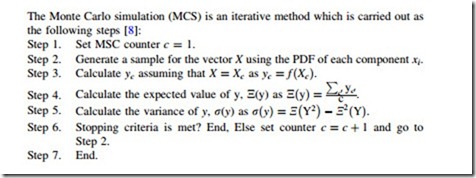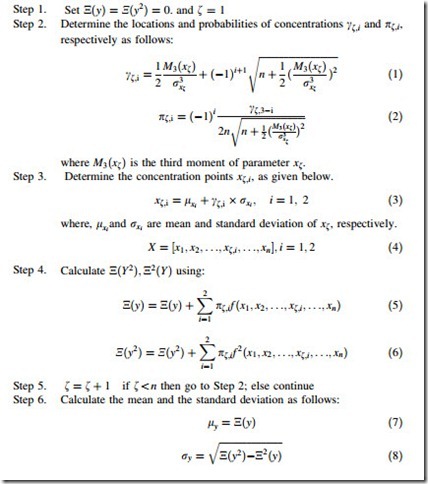Probabilistic Approach
In this approach, a multivariate function, namely y, y = f(X) is available. X is a vector containing the uncertain parameters of the form X ¼ fx1; x2; .. .; xng. It is assumed that the PDF of X is known. The question is how to determine the PDF of y? Three probabilistic uncertainty modeling techniques are described here as follows:
Monte Carlo Simulation
The Monte Carlo simulation (MCS) is an iterative method which is carried out as the following steps [8]:
The stopping criteria can be defined in various ways such as maximum number of MCS iterations, convergence of the expected value of y, etc.
• The strength of MCS method can be listed as follows:
– It is not needed to exactly know the f for calculating the y. The problem can be solved as a black box which receives samples and gives an output for each.
– It also works well in non-differentiable and non-convex problems (complex systems) as well as behavior problems.
– It supports all PDF types.
– It is intuitive and relatively easy to implement [9].
• The shortcomings of MCS method can be listed as follows:
– It is only applicable in problems that are described using a PDF.
– The computation burden is usually high since it is iterative and needs several evaluations of function f.
– This technique is approximate [9].
There are some methods for reducing the computational burden of MCS like Latin Hypercube Sampling (LHS) [10]. It is also applied in practical applications such as power systems reliability analysis with renewable energy sources [11, 12], probabilistic load flow [13, 14], evaluation of available load supply capability for distribution system [15], and assessment of capacity factor of distributed wind generation in microgrids [16].
Monte Carlo Simulation
The Point Estimate Method (PEM) is a strong technique which approximately calculates the expected value and variance of y based on the PDF of xi. If there are n uncertain parameters in vector X then this method performs 2n calculations to obtain the NðyÞ and Nðy2Þ. The PEM is implemented through the following steps [17, 18]:
• The strength of PEM method can be listed as follows:
– It is a non-iterative, computationally efficient technique.
– It is simple and easy to implement.
– There is no convergence problem.
– It is applicable to problems with spatial correlation among multiple uncertain input parameters [19].
• The shortcomings of PEM method can be listed as follows:
– It only gives the mean and standard deviation of the uncertain output [20].
– No information about the shape of the PDF of the output is provided [19].
– It gives more reliable answers for non-skewed PDFs [20].
– It is only applicable in problems which are described using a PDF.
This method is applied in various applications such as: Probabilistic power flow [21, 22], probabilistic optimal power flow in electricity markets [23], and transfer capability assessment [24].
Scenario-Based Decision Making
Usually the uncertain parameters have infinite uncountable realizations. However, it is impossible to consider all these realizations. Instead, the realization space is divided into countable finite sections (scenarios) with a specific weight (proba- bility). To do this, a list of scenarios is generated using the PDF of each uncertain parameter, X. The expected value of output variable, y, N(y) is calculated as follows:
• The strength of scenario-based decision making method can be listed as follows:
– It is computationally efficient and simple to implement.
– It converts the contentious space of uncertain environment into discrete finite scenarios with a given probability.
• The shortcomings of scenario-based decision making method can be listed as follows:
– It only gives the expected values of the uncertain output.
– The method is approximate.
– The model size tends to increase drastically with the number of considered scenarios.
– It requires probabilistic inputs and does not support uncertain parameters which are not described probabilistically.
This method is applied in various applications such as: Probabilistic determination of pilot points for zonal voltage control [25], stochastic scheduling for simulation of wind-integrated power systems [26], and wind power impact assessment [4].


